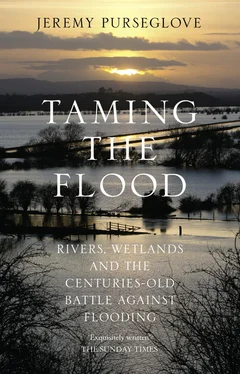Other species are less mobile, and exist there simply because a river has always been there. In 1983 a hairy snail was discovered in the Thames marshes near Kew, where its ancestors had lived for the last 10,000 years. It is believed to be the last living relic of the days when these islands were joined to Europe and the Thames was a tributary of the Rhine, where the same species of snail is still found. Now, within two years of its discovery, the snail’s survival is threatened by a Thames Water Authority scheme. fn3
Of rather more popular appeal than hairy snails, perhaps, the dragonfly best represents the ancient life of the river bank, that point where land and water meet, where life began, and where waterside plants still provide a slipway up which dragonfly larvae climb to emerge in their full splendour every spring. In the liassic rocks of Worcestershire and Gloucestershire fossil dragonflies have been found which are not very different from those still hawking along the streams that cut their way through those same rocks on their way down to the Severn estuary and the sea.

The ultimate taming of a river. The river Westbourne flows in an iron pipe above the platform at Sloane Square underground station.
Over the millennia, creatures that live in the specialized conditions of rivers have evolved by adapting to these conditions. A babbling upland brook is physically very different from a lazy lowland river, and there are subtle gradations all the way between. These differences are further modified by the local geology, which affects the water chemistry, the local climate, and the particular conditions created by the dominant local plants. Thus a river’s wildlife is adapted to, and expresses, its particular local character and that of its different reaches with an almost infinite variety.
Dragonflies are a good example of this. There are upland dragonflies and lowland dragonflies. The Norfolk hawker ( Aeshna isosceles ) is confined to the Norfolk Broads, while the brilliant emerald ( Somatochlora metallica ) is a speciality of Surrey, Sussex, and Hampshire. The Beautiful Damsel ( Agrion virgo ) favours clear, gravel-bottomed streams, while the Banded Damsel ( Agrion splendens ), distinguished from the former by the blue-black bar on the male’s wing, is abundant on muddy-bottomed, less acid waters. Where they co-exist, the former tends to prefer the gravel, while the latter chooses the clay reaches. The damsels are among the great sights of the midsummer river bank, along which they flutter, enamelled with peacock blue and green; and it is entertaining to ‘read’ the physical conditions of a particular stream from the band on a damsel’s wing.
A single rock in a stream provides at least four habitats. Algae grow on surfaces that are always wet; the dry top supports lichens; mosses thrive on the wetted margins between the two; and many creatures hide in crevices under the rock. On many upland streams a large boulder will often be the chosen perching spot of the dipper.
Further down a river, common reed is a feature of many watersides. Thickets of fawn papery stems, tender green as they unfurl in the spring, have a specialized ecology all of their own. Even quite small stands may support a pair of reed buntings, while a larger reed bed provides a home for the reed warbler. The latter is often a favourite host for the uninvited cuckoo. Look closer into the reeds, and you will find a world within a world. The twin-spotted wainscot moth lays its eggs in the bur reed, but the larvae later transfer to the common reed as they fatten up and need a thicker stem to tunnel into. In the summer dusk the pale hatched moths float out over the riverside. A specialized fly, Lipara lucens , also tunnels into the reed stems, creating noticeable swellings known as cigar galls. Once the fly has flown, the empty gall provides a winter home for two other reed specialists: a bee, Hylaeus pectoralis , and a wasp, Passaloecus corniger , whose eggs will hatch in the following spring.
Few species have adapted so closely to their particular rivers as caddis flies, stoneflies, and mayflies, which, in their turn, have been cunningly imitated for bait by generations of anglers. In the larval stages, caddis flies build themselves cases out of the materials of the river bed. These provide them with camouflage and, depending on the speed of flow, either ballast or a means of transport. The faster the stream, the heavier the material chosen, while those species occupying slow-flowing rivers or ditches construct a case of wood around themselves to help them float to fresh feeding grounds.
The nymphs, or first larval stages of mayflies, are also adapted to very particular conditions. Some nymphs have specially shaped heads and legs, so that, when facing the current, they are pushed against stones into which they fit, and which save them from being washed away – certainly a case of going with the elements! The yellow may nymph is best adapted for rough boulders, while the marsh brown nymph fits against smooth stones, upon which its gill-like plates press down, thereby creating a vacuum. While some species are streamlined for fast flows, others are burrowers and bottom-crawlers. The claret dun nymph is at home in slow, peaty streams. It is peat-coloured, and its gills both camouflage it by breaking up its outline and enable it to breathe in still water. The blue-winged olive nymph lives among weeds such as water crowfoot. It is neatly shaped to lodge in close-packed vegetation, from which it can be in close contact with the fast-flowing oxygenated water it requires.

Reed buntings and common reed.
The culmination of all this unseen evolution on the river bed is one of the great phenomena of the English countryside, once seen, never forgotten. This is the day in the life of the mayfly. Very punctually in mid-May, the nymphs will rise from the bed of the river and hatch through a final nymph stage known to anglers as ‘duns’. Then, when the air is still, the elegant adults, the ‘spinners’, float upwards in their thousands and perform their mating dance. This is the sight that stays with even the casual observer. The gauzy tides of swarming males, waiting for the females, rise and fall as if on invisible yo-yos. Having mated, grey clouds of females glide to the water, lay their eggs, and die. With all the poignancy of a Shakespeare sonnet, it is over in the space of a summer day, until next spring.
When I consider every thing that grows
Holds in perfection but a little moment. 4
The life of a river has nothing to show more resonant of changeless change than the life cycle of the mayfly, a genus known even in the dry language of science as Ephemera .
Yet the return of the mayflies is no longer as inevitable as the return of May. They are steadily declining in many rivers, and have vanished from others. Pollution and the removal of riverside hedges have played their part; but above all, dredging and drainage have ironed out the varied bed conditions of gravel and silt to which the larvae of these and many other insects were so minutely adapted.
The otter, sliding up a river like a sleek cat and whistling to its mate under the moon, is truly king of the waters, and the presence of otters on a river system sets the final seal of well-being on its wildlife. The otter has captured popular imagination ever since the classics of Henry Williamson and Gavin Maxwell. It achieved tabloid status in April 1985, when it was on the front page of the Daily Mirror ’s conservation shock issue; and, as a symbol of wildlife under threat, it is a sure money-maker for such causes as the World Wildlife Fund. The fact that people will give money to save the otter, a nocturnal animal whose presence is detected even by full-time otter survey teams only by its tracks and droppings, is the best answer I know to that mean-spirited and illogical argument: ‘What’s the use of saving it, if I can’t see it?’ It was enough simply to know that otters were out there somewhere. Alas, no longer. In 1977 leading conservationists produced a report showing that the otter had declined with disastrous suddenness. 5Whereas otters were present, even common, throughout the country in the 1950s, they are now abundant only in the extreme north-west of Scotland, leaving core populations in Wales and the West Country, and a dwindling interbred group of individuals in East Anglia. Hunting, disturbance, and pesticide residues had all played their part; but the major culprits were river boards and their successors which scoured the banks of undergrowth in which otters lay up during the day, and felled the mighty riverside trees, such as ash and sycamore, in whose buttress roots otters made their holts. Since 1977 otter hunting has been illegal, and the ban on the pesticide Dieldrin is starting to have a beneficial effect. But the many miles of treeless river inhibits recolonization by otters, and even in the 1980s there have been cases of water authority workers felling known otter holts. fn4
Читать дальше














